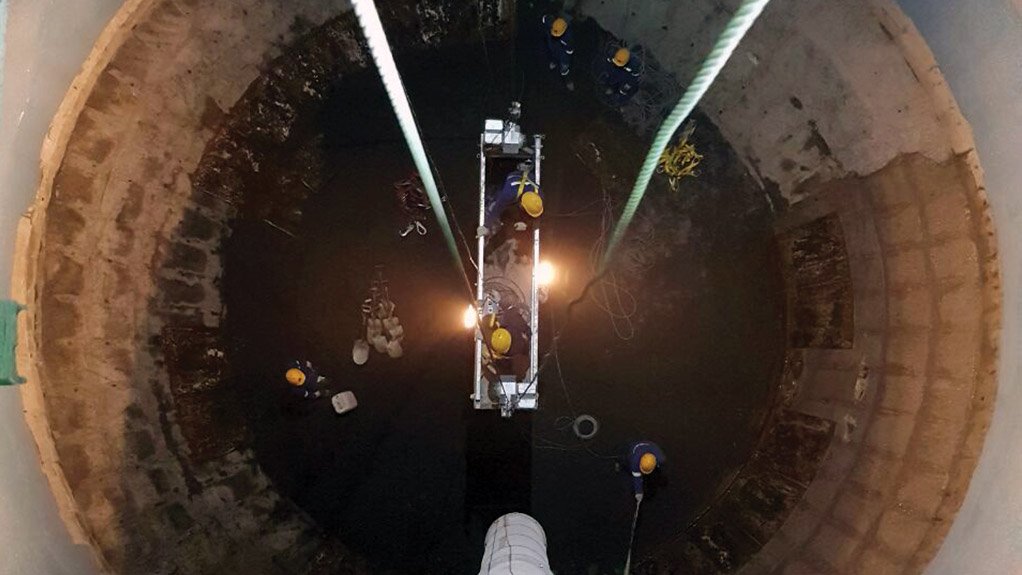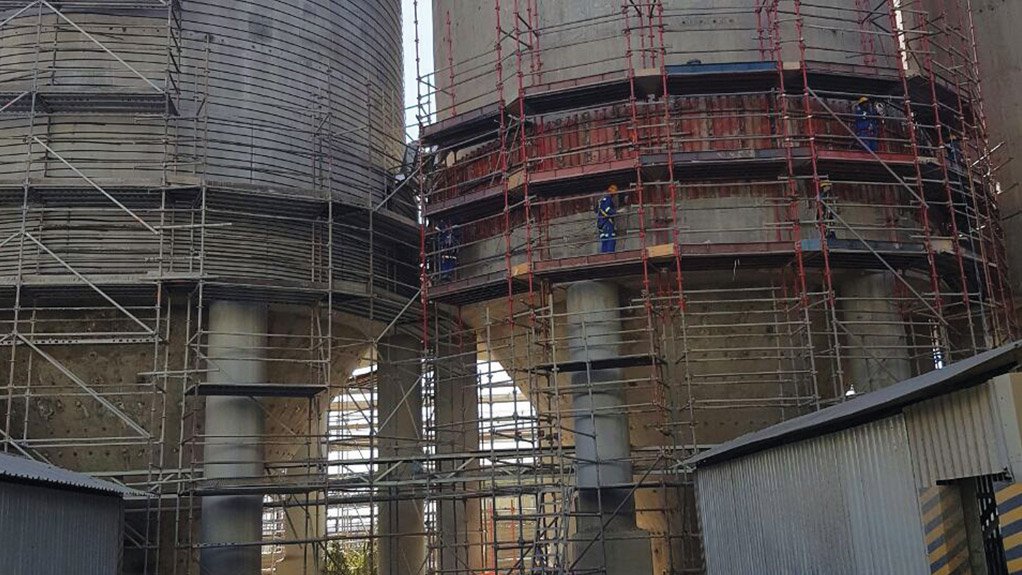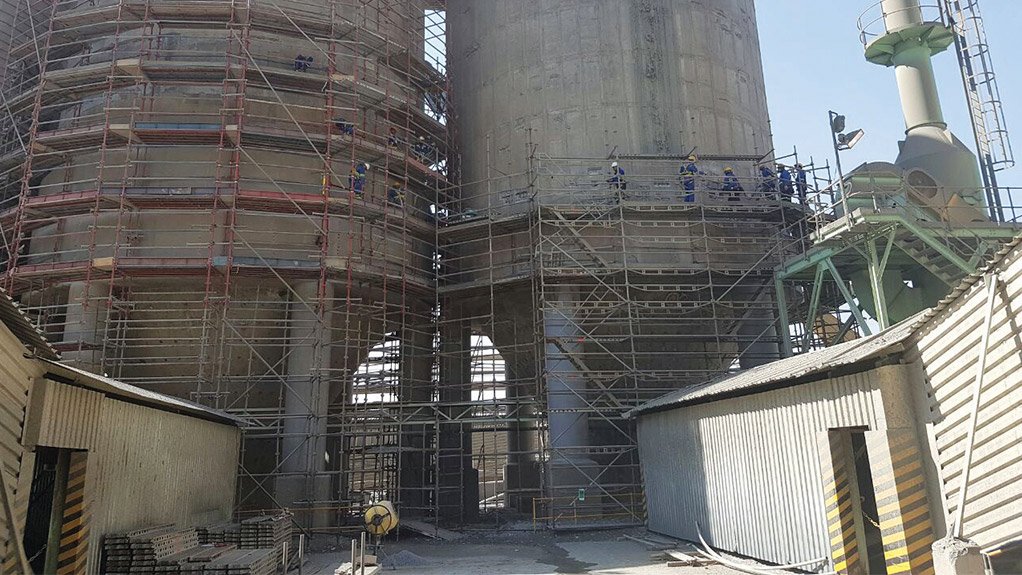Concrete Rehabilitation Success At Finsch By Botes & Kennedy Manyano
Botes & Kennedy Manyano offered Petra Diamonds a practical workable solution for the rehabilitation of three concrete silos at its Finsch Diamond Mine in the Northern Cape.
The design and construct project was aimed at restoring the structural integrity of the silos while addressing issues such as concrete and liner wear inside the structures.
Mantie du Toit, contracts manager at Botes & Kennedy Manyano, says that most importantly the solution provided an option whereby the concrete repair work would be done by taking one silo out of production at a time and recommissioning it before work would start on the next silo causing as little impact on the plant operation as possible.
Du Toit says that prior to the concrete repair work and construction taking place, Botes & Kennedy Manyano through the help of contracted consultants, was also responsible for the stability analysis of the structures. This formed part of the risk analysis phase of the project.
Construction work on this project started April 2016, and involved surface concrete repair work on the external faces of the three silos as well as on the internal faces. The spalled surfaces were repaired using various techniques depending on the severity of the damage.
Each silo has an external diameter (OD) of 13,4 metres and an internal diameter (ID) of 12,8 metres. The total height of the silo which includes a conical section at the bottom stands at 22,8 metres; the cylindrical storage section is 13 metres.
Access into the silos is restricted to entry from the top of the structure and the bottom outlet of the silo, and at the time of starting the repair work, each silo was filled to the top with kimberlite ore. The ore levels were discharged in a controlled way to a predetermine level in the silo to facilitate the concrete repair work. Use was made of a working platform lowered from the top entry giving access to the different levels going down at 2 metre increments. This was done by emptying the silos using the bottom draw point.
Outside access was facilitated through the use of scaffolding that was erected to the required height.
“During the project each of the silos was taken offline for a limited period of time, and this meant that the necessary resources had to be available to ensure optimum productivity was achieved, while still operating safely within the operational plant,” Du Toit says.
Mitigating the challenges faced by working at height required careful planning and stringent safety systems were implemented. All personnel received specific working at height training to ensure that all were competent and understood the working at height procedures. Du Toit says that the project safety statistics underpin the commitment show by the team.
Concrete repair generates a large amount of dust, and this was further aggravated by the work being done inside a silo. To mitigate this, ventilation ducting was installed to extract the dust and fumes, facilitating a much safer working environment for the personnel.
In addition to the concrete repair work on the inside of the silos, Botes & Kennedy Manyano was also tasked with increasing the wearability of these internal surfaces. This was achieved using a special epoxy product that will increase the abrasion resistance of the concrete surface
The scope of work also included the rehabilitation of the bottom cone section of each silo. Prior to this work beginning, custom carbon steel liner plates were manufactured and later installed to perform the function of protecting the concrete surfaces at the cone section. These also acted as an external shutter face to facilitate the casting of a concrete lining to strengthen the cone section of the silo. As the installation of the steel liner progressed upwards, the casting of the new 300 mm concrete lining followed the installation operation.
This was a labour intensive operation and to facilitate greater productivity in areas not subjected to interfacing with the mine, a bagged prepacked concrete mix was decided on. The bags were raised to the deck located at the top of the silo, where batching of the concrete was done in a portable concrete mixer. The concrete was then lowered from the deck level through a centre access, using a working platform with filled buckets of concrete placed on it, lowering it to the level of cast. The concrete was hand placed using the buckets and then densified. A retarder was used to lengthen the window of cast to prevent dry joints.
Attention to detail during planning as well as execution was essential to ensure that the safety of personnel was at not put at risk during this operation, and that the quality of the final product was not compromised. Some 64 m3 of concrete was used for the cone section of each silo.
A circular concrete beam was cast on the outside circumference of each silo to increase the strength and stability of the storage structure. This was done above the cone section of the silo.
Once all the concrete repair work had been completed, post tensioning was done on the outside of the structures. In total 58 strands, spaced vertically at predetermined intervals, were stressed. And this could only be done once all the repair work, both internal and external, had been completed.
Du Toit says that generally, concrete repair methods are application-specific and the solutions recommended and applied depend on the individual requirements.
“We have the necessary technical expertise and experience to assess the best course of action in each circumstance and to develop a sustainable solution such as the one applied at Finsch to rectify any issues and maximise the useful life of the structure,” he concludes.
Comments
Press Office
Announcements
What's On
Subscribe to improve your user experience...
Option 1 (equivalent of R125 a month):
Receive a weekly copy of Creamer Media's Engineering News & Mining Weekly magazine
(print copy for those in South Africa and e-magazine for those outside of South Africa)
Receive daily email newsletters
Access to full search results
Access archive of magazine back copies
Access to Projects in Progress
Access to ONE Research Report of your choice in PDF format
Option 2 (equivalent of R375 a month):
All benefits from Option 1
PLUS
Access to Creamer Media's Research Channel Africa for ALL Research Reports, in PDF format, on various industrial and mining sectors
including Electricity; Water; Energy Transition; Hydrogen; Roads, Rail and Ports; Coal; Gold; Platinum; Battery Metals; etc.
Already a subscriber?
Forgotten your password?
Receive weekly copy of Creamer Media's Engineering News & Mining Weekly magazine (print copy for those in South Africa and e-magazine for those outside of South Africa)
➕
Recieve daily email newsletters
➕
Access to full search results
➕
Access archive of magazine back copies
➕
Access to Projects in Progress
➕
Access to ONE Research Report of your choice in PDF format
RESEARCH CHANNEL AFRICA
R4500 (equivalent of R375 a month)
SUBSCRIBEAll benefits from Option 1
➕
Access to Creamer Media's Research Channel Africa for ALL Research Reports on various industrial and mining sectors, in PDF format, including on:
Electricity
➕
Water
➕
Energy Transition
➕
Hydrogen
➕
Roads, Rail and Ports
➕
Coal
➕
Gold
➕
Platinum
➕
Battery Metals
➕
etc.
Receive all benefits from Option 1 or Option 2 delivered to numerous people at your company
➕
Multiple User names and Passwords for simultaneous log-ins
➕
Intranet integration access to all in your organisation

























